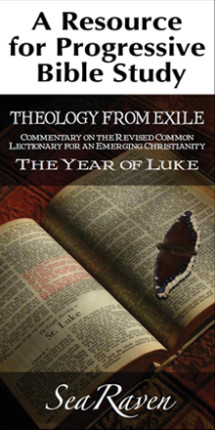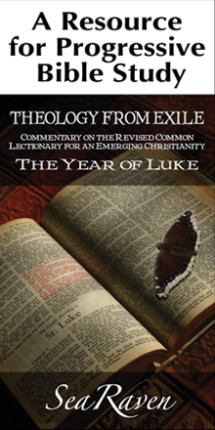Food for Thought: February 2 – The Presentation of the Lord

Excerpt from Theology of Exile Volume I: The Year of Luke
Malachi 3:1-4; Psalm 84 or Psalm 24:7-10; Hebrews 2:14-18; Luke 2:22-40

Luke’s story is grounded in the mandate in Leviticus 12, which requires the mother to follow specific rites of purification, 40 days after giving birth. But the creators of the Revised Common Lectionary seem to overturn Luke’s references to Leviticus 12 by bringing in verses out of context from the prophet Malachi. The result is that Malachi’s messenger is assumed by supercessionary Christian tradition to be John the Baptist, who is sent from God to announce the sudden coming of the Lord to his temple. That Lord (Jesus) “will purify the descendants of Levi. . . . Then the offering of Judah and Jerusalem will be pleasing to the Lord.” Why? Here a subtle, unquestioned, antisemitism seeps through. The offerings of Judah and Jerusalem are now pleasing to God because the people have been purified of the old, Jewish religion.
In Malachi’s own context, the sons of Levi have been purified by the Lord through a process that burns away faithlessness to God’s covenant. God’s covenant is not about belief. God’s covenant is about active, distributive, justice-compassion. If the liturgist does not stop at Malachi 3:4, but reads on to verse 5, God’s judgment is made clear: “I will be swift to bear witness against the sorcerers, against the adulterers, against those who swear falsely, against those who oppress the hired workers in their wages, the widow and the orphan, against those who thrust aside the alien, and do not fear me, says the Lord of hosts.”
The tradition of the Presentation of the Lord dates from the fourth century, and by the time the Revised Common Lectionary was put together, the emphasis of Malachi on the coming of the Lord’s justice was overtaken by the theology of the writer of the letter to the Hebrews. The language has deviated from salvation as liberation from injustice to salvation as freedom from the fear of death and the “one who has the power of death, that is, the devil.” The writer of Hebrews, a sermon written about the same time as Luke was writing his gospel and his sequel, the Book of Acts, pulls together much of the Hebrew scriptures and uses them to develop a particular Christology, which has little if anything to do with God’s Covenant of distributive justice-compassion, or with Luke’s subversive suggestion that Jesus the Christ came to establish God’s rule in opposition to the empire of Rome. Instead, again, verses are taken out of context to emphasize tradition. The writer is in the midst of setting up an argument that Jesus became the mediator between people and God – the High Priest. In order to achieve that position, Jesus had to first experience “the suffering of death, so that by the grace of God he might taste death for everyone” (Heb. 2:9). Because of that suffering, he was purified, and achieved the position as High Priest so that he could “make a sacrifice of atonement for the sins of the people” with his own body and blood. The ultimate sin, according to this writer, is unbelief in Jesus as the High Priest of God – the refusal of the people to accept the “better covenant, enacted through better promises” (Heb. 8:6-7) – more subtle antisemitism.
The festival of the Presentation of the Lord, also called “Candlemas,” may have begun as a celebration of the revelation of light, even rebirth from the darkness of political oppression to liberation and covenant with God’s realm of distributive justice-compassion, but the Hebrews passage casts the pall of substitutionary atonement over the festivities. Given the vagaries of the Christian liturgical calendar, which has to deal with the moon-based movable feast called Easter, the verses from Hebrews 2:14-18 perhaps serve to remind the people of the coming season of Lent.
The organizers of Christian tradition were masters of the appropriation of local cultural myth and metaphor. The Christ was nearly immediately defined as “the light of the world” (John 1:1-6). Luke’s Simeon sings what became known in Catholic liturgy as the nunc dimitis: “Now let they servant depart in peace according to your word, for my eyes have seen your salvation, which you have prepared in the presence of all peoples, a light for revelation to all Gentiles and for glory to your people Israel.” The date for the presentation has varied, depending on when Jesus’ birth was supposed to have occurred. Once December 25 was agreed upon (as opposed to January 6), February 2 became the day.
February 2 is the time in the Planet’s yearly orbit around the sun, halfway between solstice and equinox (15 degrees Aquarius), when, in the northern hemisphere, the light noticeably changes from the darkness of winter to the increasing brightness of spring. In northern agricultural life, this time of year brings the first births of livestock, and milk and eggs once again become available, if not plentiful. The Celtic Goddess of Wisdom, Bride (“breed”), in charge of poetry, smithcraft, and healing, became the Christian saint Brigid, who was reputed to have been the wet nurse for the baby Jesus. Brigid’s feast day is February 1, which conveniently appropriates the old pre-Christian festival celebrating rebirth and the increasing light (Imbolc). Milk and milk products (cheeses, butter) are on the menu for the feast. The festival mass for this day is called Candlemas. As the light returns to the world, the Christ is revealed. (Punxatawny Phil is hardly the final bastardization of sacred metaphor.)
This festival can be reclaimed, using the metaphors of justice-compassion from Malachi, Psalm 24, and Luke. The prophet Malachi challenges the leaders of the people to take care of the oppressed; the writer of the psalm says that those who are authorized to “ascend the hill of the Lord” and come into the temple are those “with clean hands and pure hearts, who do not lift up their souls to what is false.” Old Simeon says he can die in peace, now that he has seen the one who will be a light to all the world. Anna speaks “about the child to all who were waiting for the liberation of Jerusalem.”
The festival can be reclaimed using the metaphors of the natural world, the ultimate wisdom of the created universe, in which no being is denied the abundance assured by God’s Covenant of distributive justice-compassion, with a Eucharist of milk and honey, bread and wine.
One: Ho! Everyone who thirsts, come to the waters; and those who have no money, come, buy and eat! Come, buy wine and milk without price, for our God calls us away from oppression and greed to a realm of justice and love [pour wine].
God calls us away from famine and poverty to an abundance of milk and honey. [pour milk]
Wisdom orders all things well: First the grain, then the ear, then the full grain in the ear [break bread].
To inherit Wisdom is as sweet as the honeycomb [pour honey into a bowl];
Wisdom has set her table. She calls from the highest places, “Come, eat of my bread and drink of the wine I have mixed. Come, for all has been made ready.”[All are invited to come to the table, dip bread into milk, honey or wine. Take as many pieces of bread as is desired. Some may wish to feed one another.]
